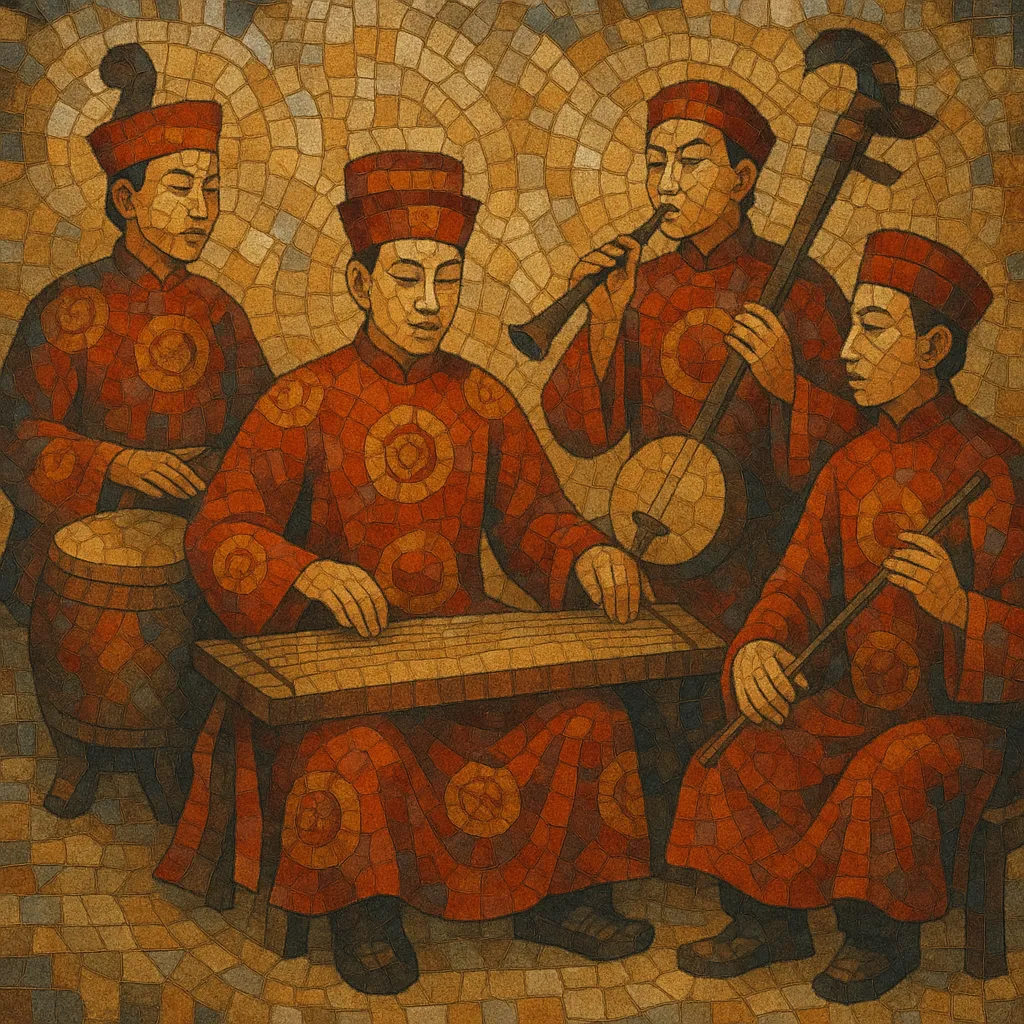Vietnamese court music, known in Vietnamese as "Nhã nhạc" (literally "elegant music"), is the refined ceremonial and entertainment music of the Vietnamese royal courts.
It was cultivated from at least the 13th century and reached a high degree of codification and splendor under the Nguyễn dynasty (1802–1945) in Huế. Court ensembles were organized into two principal types: đại nhạc ("great music"), featuring powerful percussion, gongs, and double-reed oboes for outdoor and processional functions, and tiểu nhạc ("small music"), a more intimate chamber group of strings, flutes, and light percussion for indoor ceremonies.
Musically, Nhã nhạc favors pentatonic-based modal systems, heterophonic textures, and ornate ornamentation. It accompanied rites such as coronations, New Year celebrations, diplomatic receptions, and ancestral worship, often in conjunction with stately dances, lavish costumes, and precise ritual choreography. In 2003, UNESCO recognized Nhã nhạc as a Masterpiece of the Oral and Intangible Heritage of Humanity.
Nhã nhạc emerged in the royal courts of Vietnam during the Lý and Trần periods (notably the 13th century). It developed within a Confucian court culture that valued ritual order and musical propriety, drawing on Chinese imperial ceremonial practices while adapting them to local Vietnamese aesthetics. Indigenous instruments and melodic sensibilities blended with imported court protocols, laying the groundwork for a distinctly Vietnamese court style.
From the 15th century onward, successive dynasties formalized the repertory, ensemble organization, and performance etiquette. The Nguyễn dynasty (1802–1945), after establishing Huế as the imperial capital, elevated court music to a symbol of royal authority and cultural prestige. The music divided into đại nhạc (large, outdoor/processional) and tiểu nhạc (small, indoor/chamber), supported by royal workshops that maintained instruments, trained musicians, and preserved repertoire. Ritual dances and ceremonial dramas were integrated into grand court events.
Court ensembles combined strings (đàn tranh zither, đàn nguyệt moon lute, đàn tỳ bà pear-shaped lute, đàn nhị two-string fiddle), flutes (sáo trúc, tiêu), double reeds (kèn bầu/oboe), and percussion (various trống/drums, chiêng/gongs, chập chõa/cymbals, phách/clappers). The music employs pentatonic modal frameworks with Vietnamese modal concepts (e.g., Bắc for brighter characters, Nam for contemplative/melancholic ones), heterophonic interplay of parts, measured tempi, and heavily ornamented melodic lines.
With the abolition of the monarchy in 1945, court functions diminished and the tradition waned. From the late 20th century, scholars, artisans, and cultural institutions undertook documentation and restoration. In 2003 UNESCO inscribed “Nhã nhạc, Vietnamese court music” on the Representative List of the Intangible Cultural Heritage of Humanity, catalyzing training programs, instrument-making, and staged presentations (notably in Huế). Today, performances at festivals, museums, and conservatories maintain the lineage and transmit it to new generations.
Decide whether your piece is for đại nhạc (grand, ceremonial/outdoor) or tiểu nhạc (chamber/indoor). For đại nhạc, emphasize percussion (trống, chiêng), cymbals (chập chõa), and oboe (kèn bầu) to project outdoors. For tiểu nhạc, feature strings (đàn tranh, đàn nguyệt, đàn tỳ bà, đàn nhị), bamboo flutes (sáo trúc, tiêu), light percussion (phách), and restrained oboe for color.
Use pentatonic-based modes with Vietnamese modal affects: hơi Bắc (bright/ceremonial) and hơi Nam (contemplative/melancholic), sometimes with oán inflections for deeper pathos. Compose a lyrical core melody and realize it heterophonically—each instrument decorates the same line with idiomatic ornaments (slides, mordents, grace notes, subtle portamenti, vibrating tones).
Adopt measured, processional tempos for ceremony and moderate to slow tempi for indoor ritual pieces. Structure the rhythm using cyclical beats marked by drum cues and clappers; cadences are signaled by percussion calls. Formally, organize pieces as suites aligned with ritual steps (entrance, offering, homage, recessional), or as paired pieces with complementary characters (Bắc then Nam). Allow brief rubato introductions (rề or dạo) before settling into the main cycle.
Maintain a dignified, balanced sound. Keep the oboe’s penetrating tone as a leader in outdoor contexts, while strings and flutes carry nuance indoors. Ensure heterophony remains transparent: different lines should embellish the melody without obscuring it. Favor clear dynamic contours over dramatic contrasts, preserving ceremonial gravitas.
While modern cipher notation can assist, prioritize oral/aural transmission and stylistic imitation from masters. For staged performance, coordinate music with court dance steps, ritual gestures, and costume, respecting the pacing and solemnity of the rite being represented.


